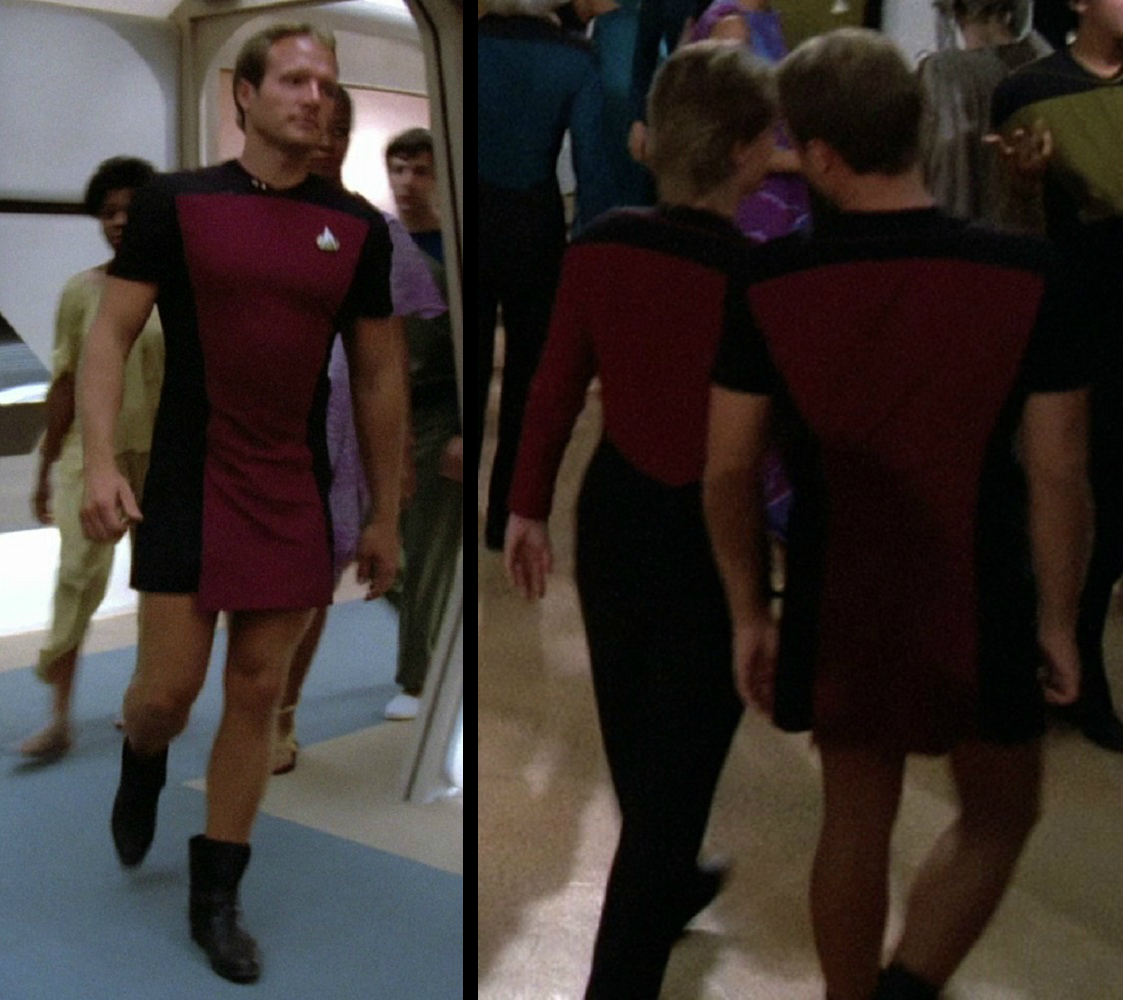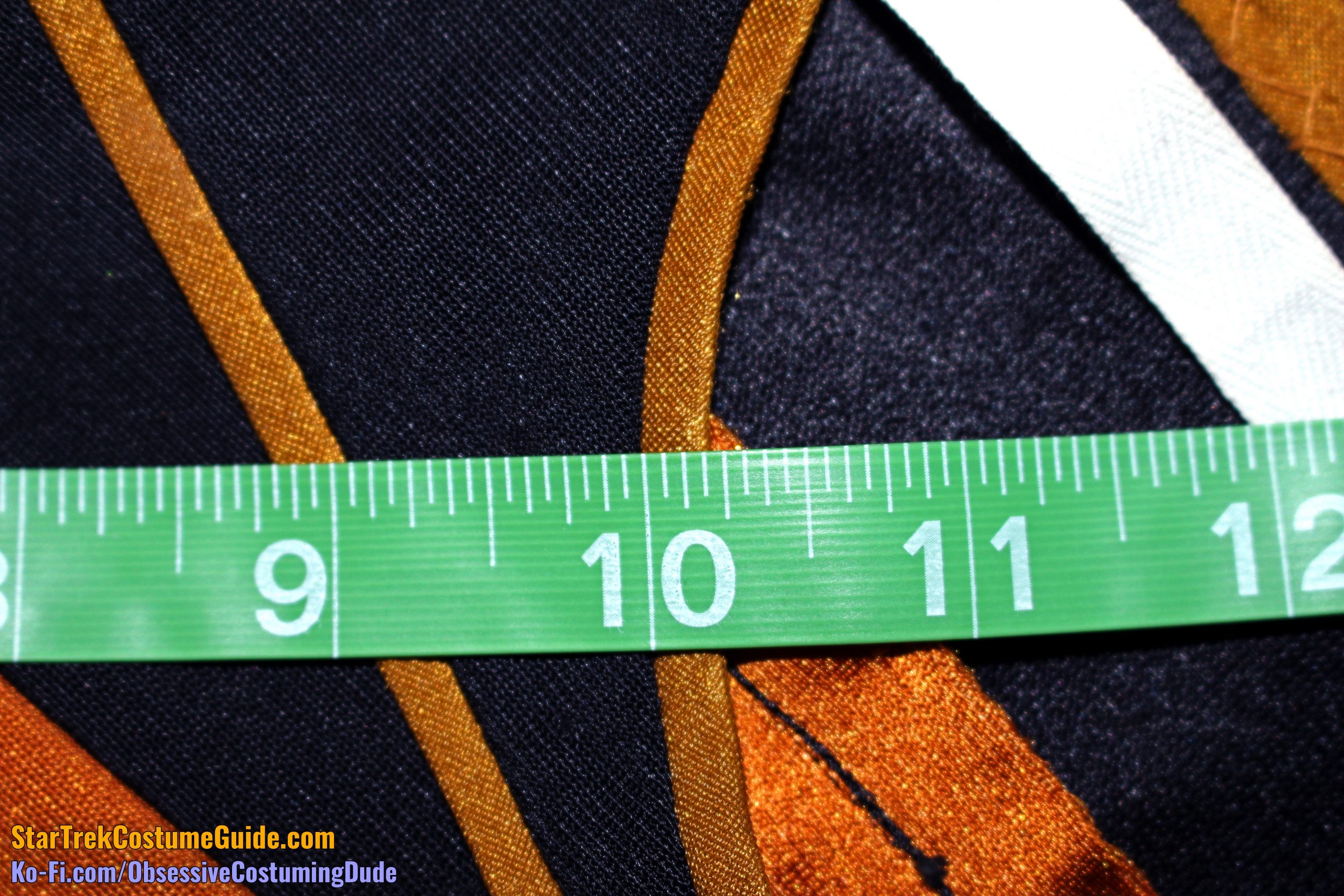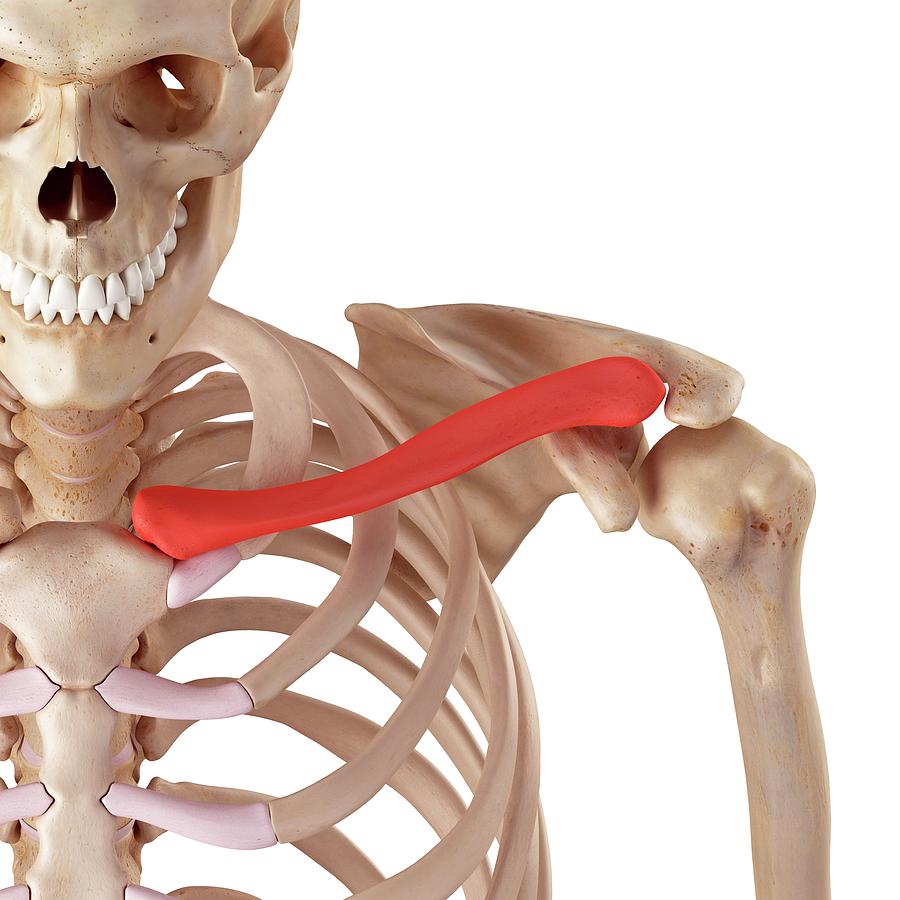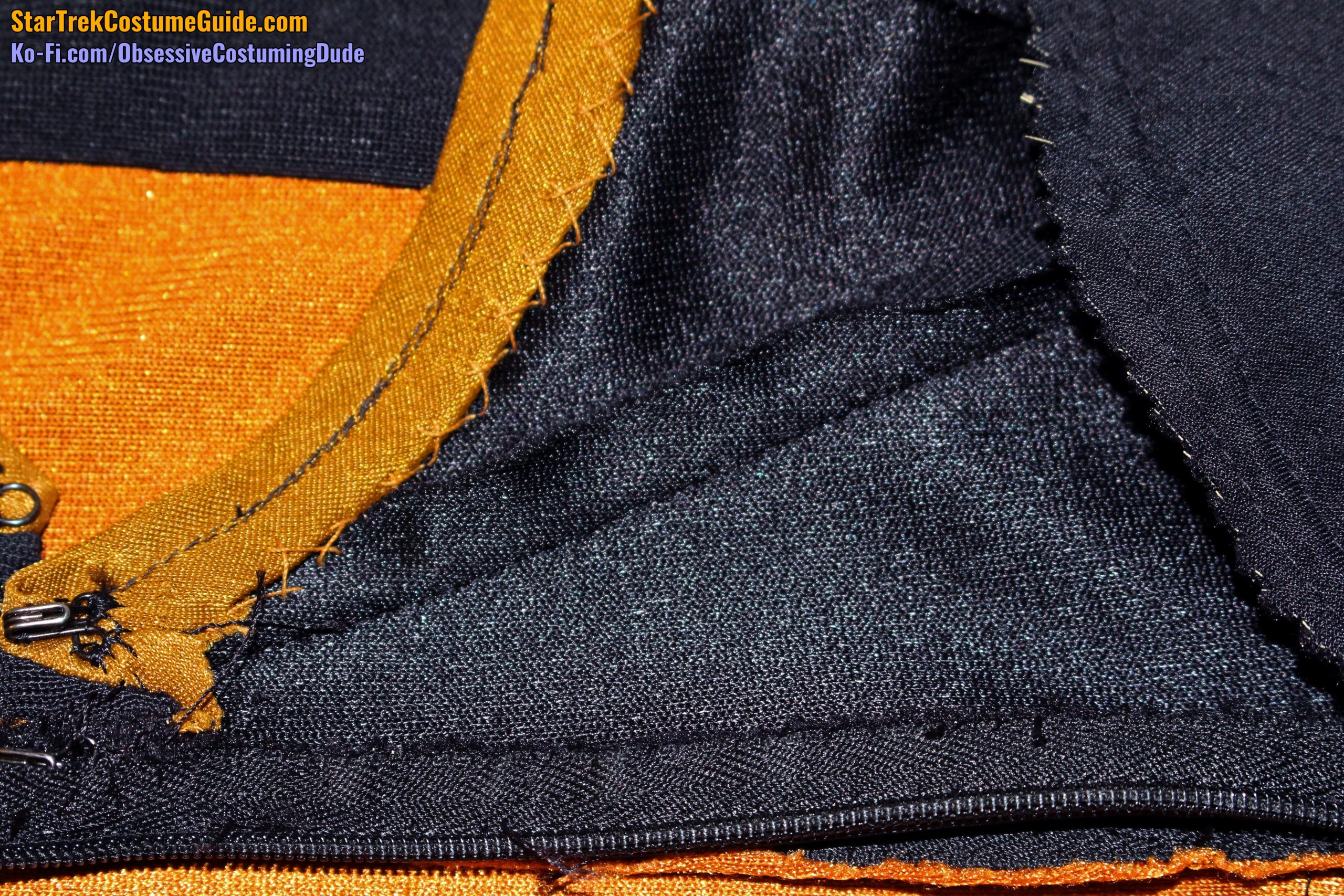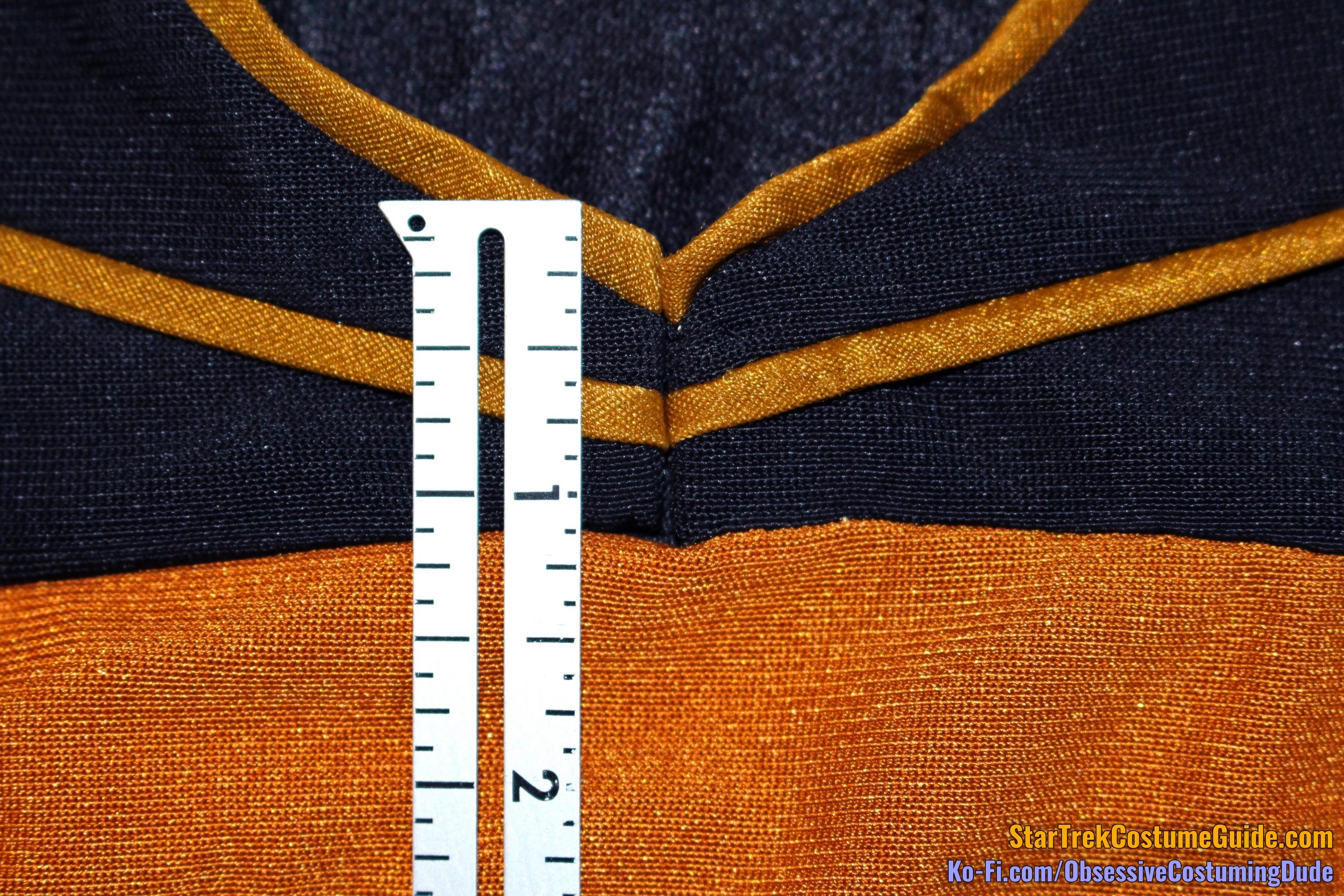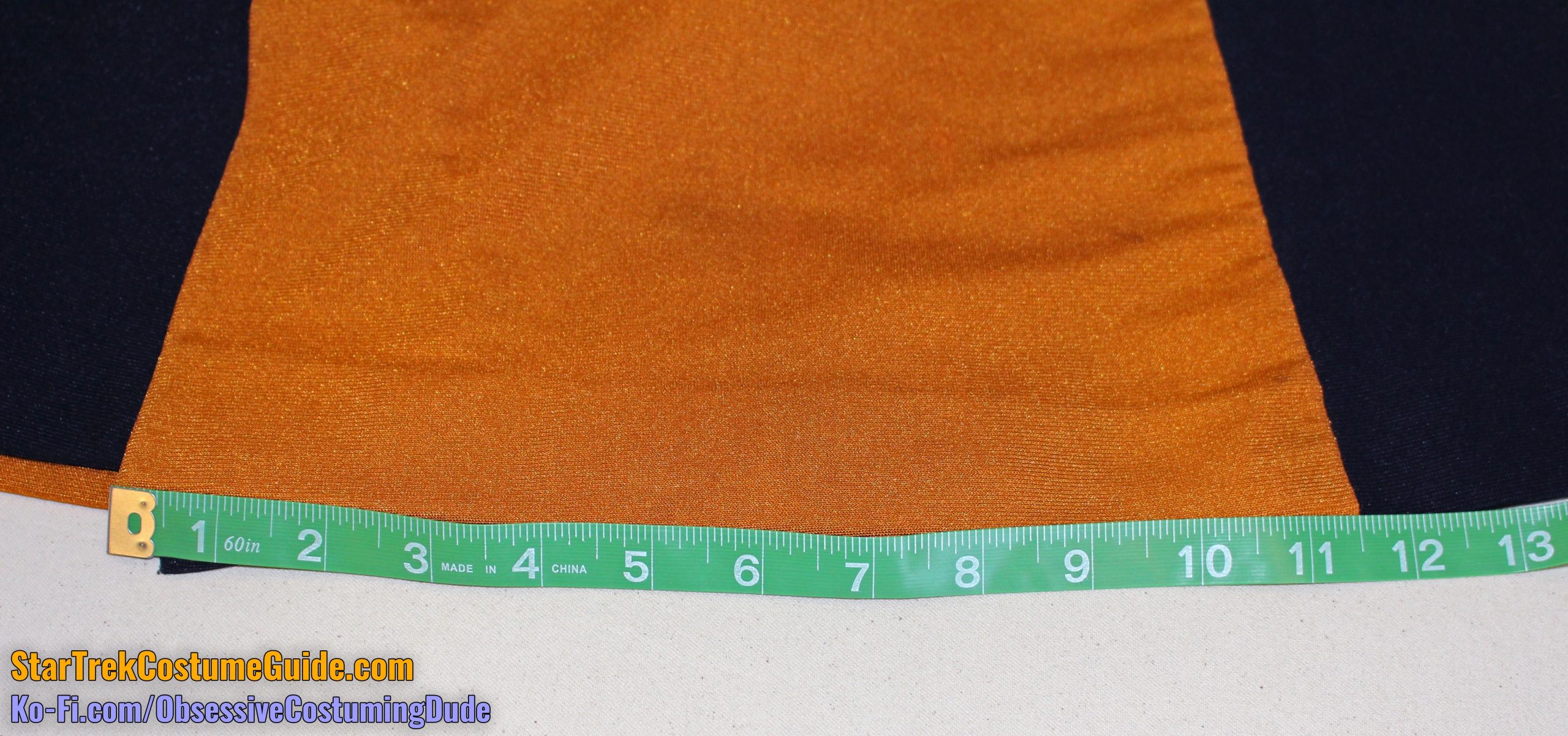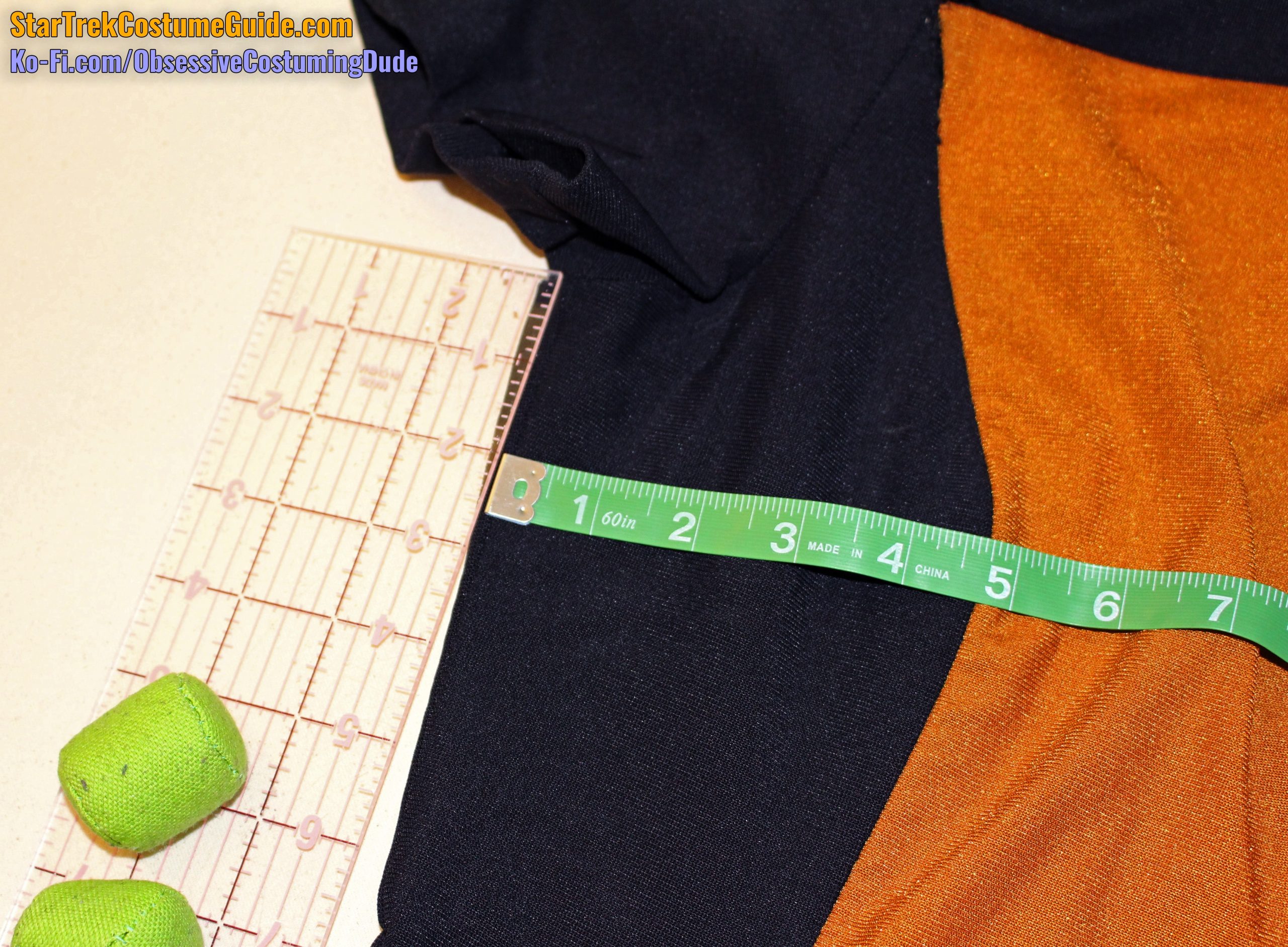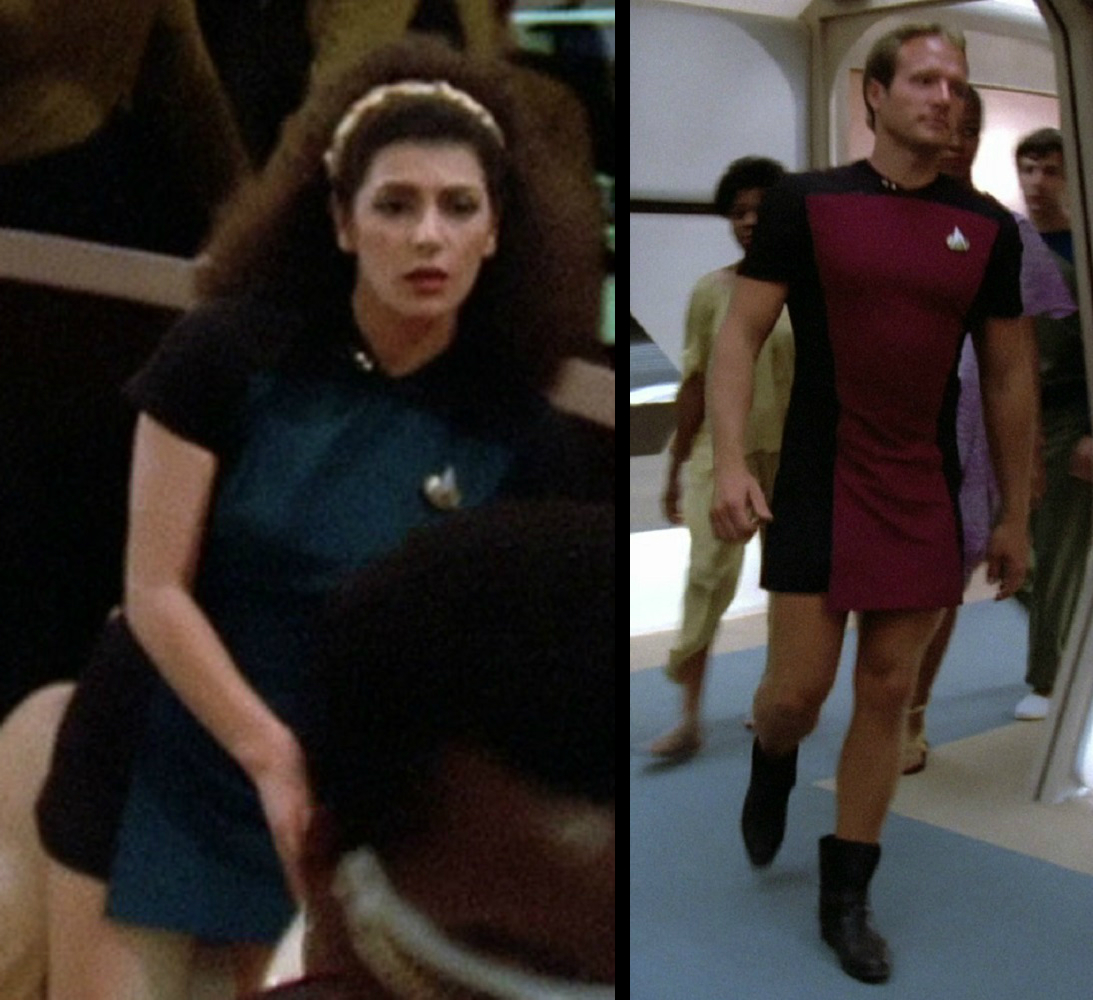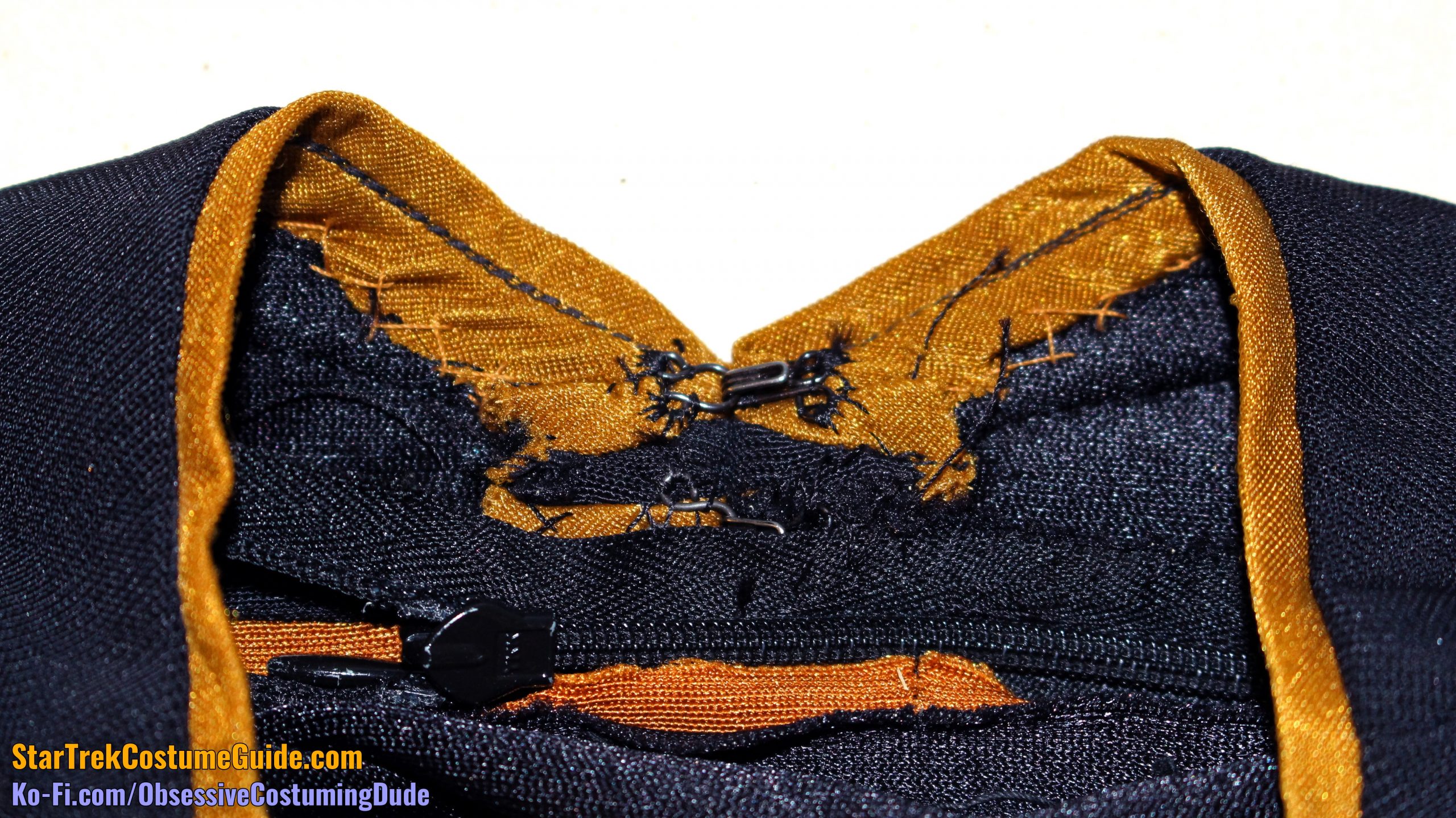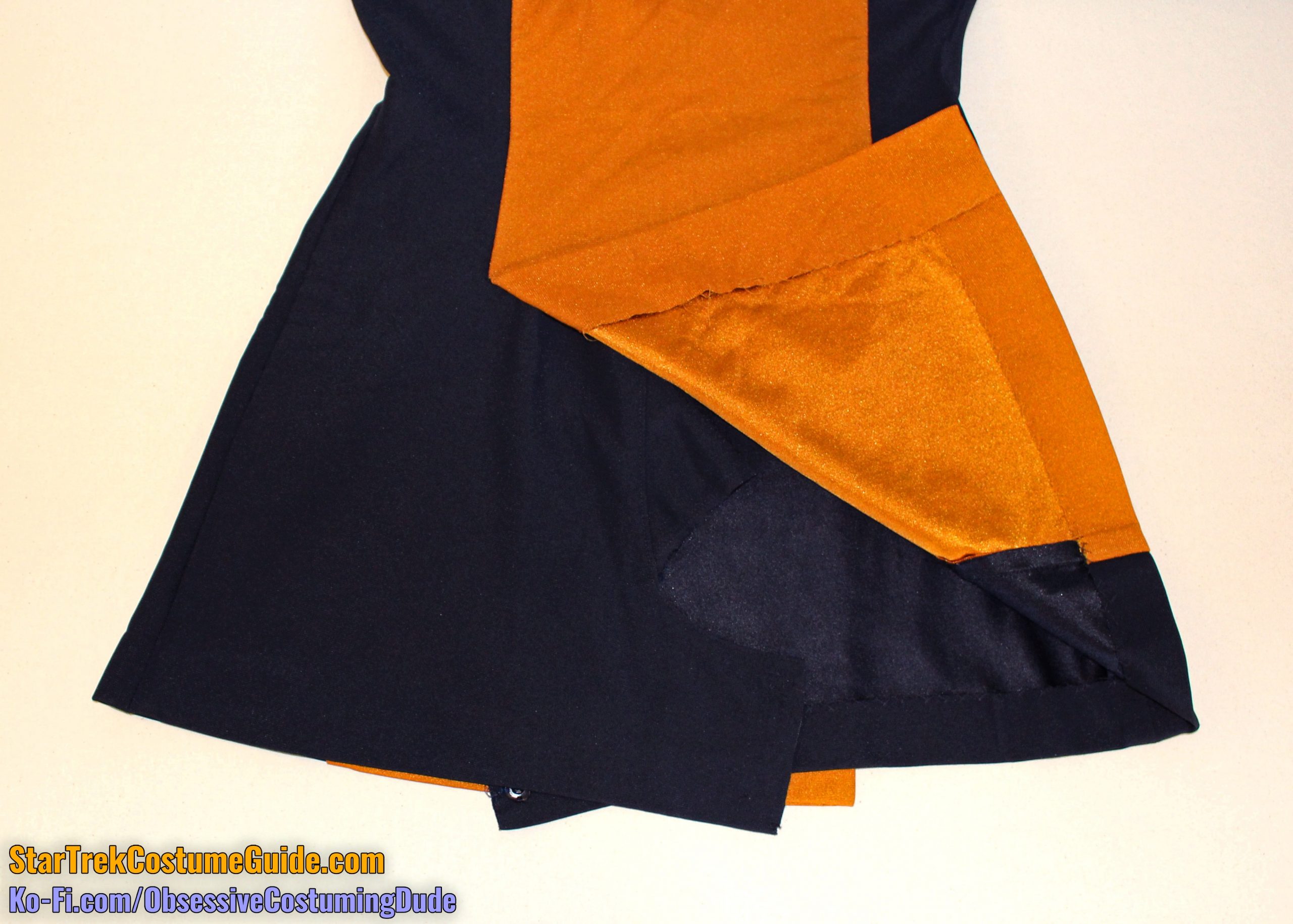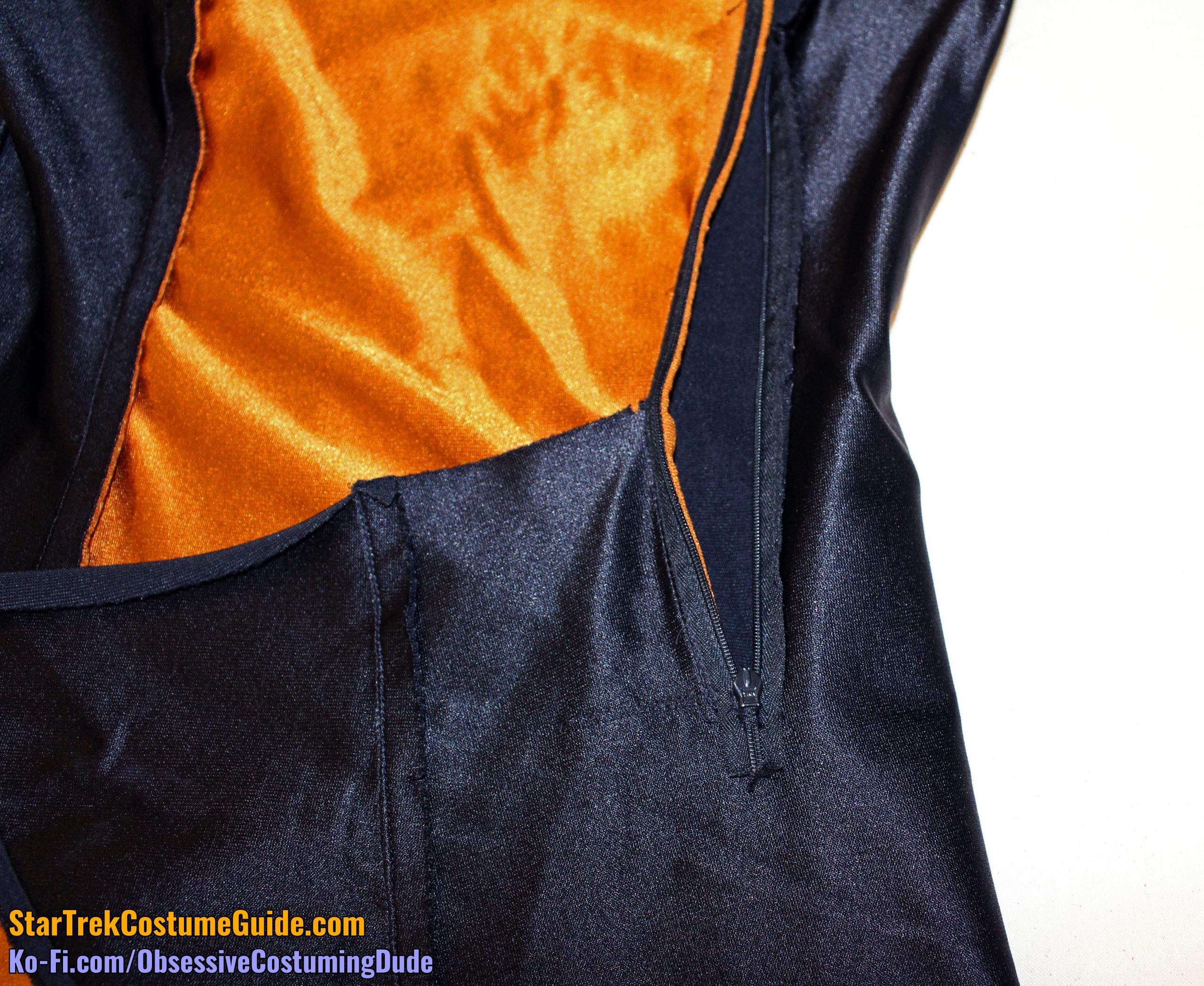Fabric and Fit
As with all of William Ware Theiss’ TNG-era Starfleet uniform designs, the TNG skants were made of jumbo spandex (except the neckline/yoke piping, which was a lighter-weight spandex).
Also typical of Theiss’ TNG-era uniforms, the jumbo spandex was cut with the fabric “weave” oriented horizontally, so the fabric stretched vertically (instead of around the wearer’s body).
Also characteristic of Theiss’ TNG-era uniforms, the dull side of the jumbo spandex was used as the “right” side, with the shiny side of the fabric serving as the underside.
Like the TNG-era jumpsuits, the TNG skants were quite form-fitting, but whereas the TNG jumpsuits merely “outlined” all, the skants truly revealed quite a bit of the wearer’s body …
To don this particular garment, one ideally has an extremely fit body, plenty of “guramba,” or both!
Division Colors
As I mentioned in my TNG-era Uniform Paradigm blog post (and its corresponding video), Theiss returned to the three Starfleet division colors he’d established in The Original Series:
“Red” was for walking or generally milling around. (Also theoretically for command, and maybe helm?)
“Gold” was most commonly seen for engineering, which made sense because they did resemble busy little worker bees.
Like the “red” division color, “gold” was also for walking around in the background, although perhaps more purposefully and/or while carrying things.
In-person, the actual fabric colors are noticeably – even shockingly – different than how they appeared in the shows and movies.
Having had the benefit of studying (and color-matching) numerous screen-used uniforms and swatches of screen-used uniform fabric from over the entire series, I can unequivocally say that the colors varied radically and evolved considerably over the years.
To avoid redundancy, I will be discussing the evolution of the screen-used TNG-era fabric colors (with side-by-side comparisons) in a future blog post.
I suggest subscribing to my “Costume Guide” e-mail newsletter and following me on social media (if you haven’t already) for updates on this, and other new costuming resources.
In the meantime, you can check out some of my screen-used costume examinations here on the blog, for which I use visual aids like Pantones, paint chips, and thread spools as color references.
Now that we’ve discussed some of the ideology and stylistic inspirations for Theiss’ TNG skants, and the fabric they were made with, let’s take a look at the construction of the skant itself!

Neckline and Yoke
The neckline and yoke on the TNG skant was fairly analogous to that of its counterpart, the early TNG jumpsuit.
(They were part of the same uniform family, after all.)
However, the skant neckline doesn’t appear to have been quite as the jumpsuit’s was.
The neckline on the screen-used women’s TNG skant I examined was only about 4 ¾” at its widest – about where the shoulder seams were.
The lower yoke extended over the shoulder onto the upper sleeve, cut as a continuous piece; there was no “traditional” upper armscye seam.
This formed an unusual yoke/armscye/sleeve construction.
Here’s a close-up photo the screen-used TNG skant I examined, in which you can more clearly see the yoke extending over the shoulder onto the upper sleeve area.
Both the neckline and yoke were embellished with division-colored piping.
This “piping” was a thin strip of lightweight spandex, bias-cut, and simply folded in half without any cording (rounded or otherwise).
On all of the early TNG uniforms I’ve examined, the lightweight spandex used for the piping was a close, but not exact color match to the division-color jumbo spandex used for the uniform body.
Here, you can see the slight color/sheen differences between the jumbo spandex and lightweight spandex used for the neckline/yoke trim.
As typical on Theiss’ early TNG-era uniforms, the neckline trim on the screen-used TNG skant I examined was precisely 3/16” wide.
Also like the early TNG jumpsuits, the neckline trim was simply folded in half, sewn onto the skant’s neckline, and turned under; there was no “yoke facing” or comparable paneling on the underside of the yoke.
Note the catch-stitching on the underside of the neckline trim, securing it to the underside of the yoke.
Curiously, this was done in division-colored thread, rather than black.
I mean, the color-match looks good on the interior neckline, sure … but while the stitching would ideally be invisible on the outside of the garment, why risk having little pinpricks of gold thread around the black yoke’s neckline?
The front yoke piping appears to have followed the general contour of the human clavicle (“collarbone”).
For what it’s worth, on the screen-used TNG skant I examined, there was very little curve to the yoke piping, on either the front or the back.
The gentle curve toward the shoulder appears to have been naturally achieved by the drape of the garment on the wearer.
(In this case, the measuring tape is irrelevant to the point I was making about the yoke piping contour.)
As with the neckline piping, on the TNG skant I examined, the yoke piping was precisely 3/16” wide.
Both the front and back yokes were actually two separate pieces (upper front yoke, lower front yoke, upper back yoke, lower back yoke), with a seam establishing the contour of the yoke piping.
The strip of lightweight spandex (used for the yoke piping) was sewn into the yoke seam, and the allowances were pressed upward.
Although this varied among the screen-used TNG uniforms I’ve examined, in this case of the skant I examined, the yoke piping allowance was trimmed to about ⅛”.
The center front yoke depth of the TNG skant appears to have been comparable to that on the early TNG jumpsuit, although both varied considerably.
As you might recall from my TNG jumpsuit analysis, the yoke depth on the jumpsuits fluctuated over the course of the first season and grew significantly deeper over the course of season two.
Counselor Troi wore several different TNG skants over the course of The Next Generation’s pilot, and their yoke depths were subtly inconsistent.
One her skant yokes was close to (what I believe to have been) the ideal dimensions, equally-proportioned between the two black areas and lengths of trim.
Sometimes the upper and lower yokes were a bit deeper at the center front, effectively widening the trim spacing and slightly deepening the general area.
Sometimes the yokes were even deeper – perhaps ½” each.
At least one of her TNG skants from the final episode had a similarly deep yoke.
Sometimes the upper and lower yokes weren’t equivalent depths; one might be deeper than the other, skewing the proportions at the center front so the yoke piping was no longer vertically centered between the upper and lower edges.
For example, this particular skant yoke was a bit “top heavy” at the center front – the upper yoke was slightly taller than the lower yoke.
As a contrasting example, this skant yoke was slightly “bottom heavy.”
And this skant from the final episode was similarly disproportioned.
The screen-used TNG skant I examined had one of the slightly deeper yokes – 1 ⅛” tall (including the neckline trim) at the center front, although thankfully the yoke piping was vertically centered between the neckline trim and the upper edge of the front body panel.
Using the “weave” of the jumbo spandex as a guide, one can observe that the lower edge of the front yoke wasn’t cut horizontally, but it curved downward away from center.
On the front yoke, the lower edge curved downward approximately ½” from center front to armscye.
The back yoke also curved downward ½” from center back to armscye.
Body Panels
Making our way downward from the yoke, one can see that in addition to the neckline and yoke piping, the wearer’s division was indicated by division-colored center panels.
On the screen-used TNG skant I examined, the front yoke/body seam allowances were pressed open.
The upper edge of the front panel was also cut so it curved downward away from center.
Again using the “weave” of the jumbo spandex as a guide, we can observe that the upper edge of the front panel curved downward ¾” from center front to armscye.
Note that the upper front curved downward slightly more than the lower yoke did, resulting in a fitted seam that functioned like a dart would.
This division-colored front panel wasn’t rectangular, but more of an “hourglass” shape.
It was wider at the top, narrowed toward the waist, then widened again downward toward the lower hem.
Generally speaking, the “hourglass”-shaped front panel was more pronounced on the ladies’ uniforms than the men’s.
On the screen-used women’s TNG skant I examined, the upper front edge was approximately 12 ½” from corner to corner. It tapered to 8 ½” wide at the waist, then widened again to 11 ½” at the bottom.
A particularly nice touch is that the division-colored front panel and black side panel met at the yoke/body/armscye seam line, forming a three-way “intersection” of seam lines.
These body panels were carefully drafted and constructed so the seam lines would intersect at exactly the same point.
Unlike the TNG jumpsuits, there were no bust darts on the TNG skants.
Instead, the extra bust allowance was incorporated into the side panels via princess seams.
On the screen-used women’s TNG skant I examined, the vent was 12” on the front panel, but the side panel was slightly shorter, with the vent only being about 11 ¼” tall.
The vent allowances were simply turned under and hand-sewn into place via catch-stitching.
Curiously, the front vent’s hem allowance was 2″ at the top of the vent, but this widened to 2 ⅜” at the bottom of the vent.
The back of the TNG skant was styled similarly to the front.
However, while the front yoke/body seam allowances were pressed open, the back yoke/body seam allowances were pressed upward.
The back shaping on the screen-used TNG skant I examined was slightly more pronounced than the front’s.
The upper edge of the center back panel also curved downward away from center.
However, it curved downward a full inch from center back to armscye – again forming a fitted seam that also functioned as a dart toward the shoulder.
The back panel’s “hourglass” shape was also slightly more pronounced.
The back dimensions were very close to those of the front, but it had a slightly more extreme taper, going from 12 ½” wide at the top to 8″ at the waist, then widening again to 11 ½” at the bottom.
The back panel of the TNG skant mirrored the front; the back right was sewn closed, but there was a vent on the lower left.
The back vent’s construction was basically the same as the front’s.
On the screen-used TNG skant I examined, the center back panel was slightly longer than the side panel (11” and just shy of 10 ½”, respectively), although overall, the back vent was slightly shorter than the front.
Unlike the front, though, the back vent’s hem allowance was consistently 2 ¼” from top to bottom.
In addition to the division-colored front and back panels, there were four black side panels (two on each side).
These side panels were also shaped, narrowing downward toward the waist and widening toward the lower hem. (And as I mentioned previously, for the ladies, the extra bust fullness was incorporated into the black side panels.)
Below the waist, the side panels flared out considerably on the women’s version, resulting in the full “skirt” that gave the lower area of the skant its “bell” shape.
On the screen-used TNG skant I examined, the body seam allowances were all ½” and pressed toward the front (except the zipper’s – more on that shortly).
However, the side seam allowances were ⅝” and pressed open.
Closure System
As you may be aware, one of Gene Roddenberry’s precepts regarding clothing in his vision of the future was that all closures must be completely hidden; fastenings like zippers, snaps, buttons, etc. must never be seen.
Allegedly, his reasoning was that hundreds of years in the future, fashion and technology will have evolved beyond today’s closures, so clothes will fasten differently and less obviously.
Completely invisible closures also add a certain mystique to the universe we’re observing; if the audience has no idea how the characters dress or remove their uniforms, the mystery of it all helps suspend their disbelief.
(This is also common with superhero and fantasy costumes.)
On most of the TNG-era Starfleet uniforms, this was accomplished by use of an invisible zipper with the uppermost inch or so hanging free and a pair of hook-and-eye closures above to fasten the uniform closed, thereby completely concealing the zipper closure.
However, as you’ve seen, the TNG skant didn’t have a center front or center back seam under which to hide a zipper closure.
And in a behind-the-scenes interview with Marina Sirtis, one could also see a zipper pull tab at the center front of the yoke/body seam.

The TNG skant’s closure system was truly bizarre, and near-impossible to accurately reverse-engineer based solely on external reference images.
Even holding an actual, screen-used TNG skant in my hands, it took me a little while to figure out exactly how everything was supposed to work.

I’ll walk you through the unfastening process, so you can see for yourself.
On the underside of the center front was, unsurprisingly, a pair of hook-and-eye closures.
An invisible zipper was horizontally positioned along the right yoke/body seam allowance, extending past the actual seam in both directions. At the center front the upper side of the zipper tape was left hanging free.
The zipper pull was hidden underneath the yoke and the lower zipper tape was fastened down onto the seam allowance.
To start, one must undo the front hook-and-eye closures.
Then the upper, horizontal zipper is unzipped away from center.
Again note that the zipper actually overhangs both ends of the yoke/body seam.
That’s not all, though; now there’s room for the head to go through the neck hole, but what about the torso?
Well, in that upper right (photo left) intersection of seam lines was another pair of hook-and-eye closures which must be undone.
(The screen-used TNG skant I examined actually had thread “eyes,” rather than metal ones.)
As a side note, the seam allowance was reinforced underneath the area where the second pair of hook-and-eye closures was attached – perhaps with silk organza, or a fusible interfacing long since detached?
Beneath that second pair of hook-and-eye closures was another invisible zipper – this one vertical, running down the front/side seam from the yoke to the lower vent.
The top of this zipper extended past the seam and was left hanging free as well.
Unzip that second zipper, and the skant is ready to be donned!
(Because of course. How else would you get in and out of this thing?!?)

(FYI, you can watch me demonstrate this unfastening process in my TNG skant video tour.)
Length
Even just standing around or walking could be a bit risky, if one were at all modest or sheepish.
Sitting down totally meant butt cheeks on the seat.
On the women’s TNG skant I examined, both the front and back panels measured 29″ from the bottom of the yoke to the hem fold.
Thankfully, the men’s TNG skants appeared to be a few inches longer.

Curiously, the men’s TNG skant “Stasiuwong” was kind enough to measure and photograph appears to have only been about 30” long – barely any longer than the women’s that I examined.
Perhaps it was intended to be worn by a shorter actor?
I’m not sure how to otherwise reconcile this obvious difference in length …
Lower Interior and Hems
Perhaps because these TNG skants were so short and/or to prevent them from riding upward, Theiss incorporated an unusual contraption underneath.
The best way I know to describe it is a “half-underwear” assembly in combination with an interior waist anchor.
Or, imagine opposing halves of a “skort” meeting across the legs.
(Seriously, that’s the clearest description I could come up with – see for yourself!)
Here’s what the lower front looks like, lying flat:
However, if I lift the front vent, you get a peek at the lower interior construction.
Pulling the side as far out of the way as I can, you can see what appears to be a slightly K-shaped assembly, the upper corner of which was fastened to the side seam allowances.
The fabric directly beneath the vent was a continuation of the side panel, cut-on as a single piece, but there’s a separate, basically triangular piece attached to it.
Also note that the black side panel extended several inches above the vent, and the top edges of both the side panel and the semi-triangular extension (which I’ll refer to as the “interior waist anchor”) were left raw.
With the skant turned entirely inside-out, the interior assembly is more easily observable.
With everything more clearly visible, again note how the “interior waist anchor” extension was fastened to the opposite side seam allowances.
The result is the wearer feeling like they’re wearing shorts or underwear of some kind.
Since the vertical invisible zipper extended downward to the bottom of the vent, it extended downward into the lower side panel, too.
Because the side panel was cut as a single piece, a slit had to be cut into it to accommodate the zipper, so there was very limited seam allowance available toward the bottom.
For some reason, the “interior waist anchor” was cut separately and sewn onto the centermost edge of the side panel.
(The center front seam line appears to have served no purpose, except perhaps to allow the costuming department to remove and replace “interior waist anchors” of different sizes/widths for fitting purposes?)
The ½” seam allowances were pressed toward the side panel and edge-stitched.
Beneath that, the upper edge of the leg strap was pressed under and edge-stitched, although the allowance was reduced to ⅜” and clipped to accommodate the curve.
The long, diagonal end of the “interior waist anchor” extension was stabilized with ¼” black cotton twill tape, which was simply fastened to the fabric with two rows of topstitching.
At the bottom of this whole assembly was what I refer to as the “leg strap,” which snapped closed across the wearer’s opposite thighs (right front to left back) to form a sort of “half-boxer-brief.”
The back interior was basically the same construction as the front, except for the lack of any zippers.
The final result of all this is, as I originally described it, a sort of “half-underwear” contraption in combination with an “interior waist anchor” – but now, that hopefully makes sense!
Still though, it can be difficult to envision while lying flat, so here’s how the skant interior looks while being worn (by a mannequin, in this case):
Whatever else might be said about William Ware Theiss or his work, personally I admire his out-of-the-box thinking and general creativity.
(I, for one, would have probably never come up with this whole contraption. I would’ve either just made it a normal skirt and called it a day, or possibly made it a full-on “skort” instead of the mirrored asymmetrical thing he did.)
At the bottom of the skant, the hem allowances were simply turned upward, pressed, and hand-sewn into place.
Curiously, the hem allowance at the front corner of the vent was 1 ¾”, but this gradually tapered down to 1 ½” at the side seams.
The back hem allowance was similarly tapered.
Across the sides and “leg anchor,” though, the hem allowance was consistently 1 ½”.
The lower edges of the skant weren’t cut or hemmed straight (horizontally or otherwise); just look at that graceful curve …
(Theiss seems to have LOVED curves.)
Armscye and Sleeves
Like the TNG jumpsuits, the TNG skant “silhouette” was gently rounded over the shoulders.
Also as with the TNG jumpsuits, the only real structuring was with the custom-made, raglan-style shoulder pads.
Although they had a large surface area, there was only a slight amount of loft to them. They were likely only intended to smooth the yoke as it extended over the shoulder onto the upper sleeve area.
On the screen-used women’s TNG skant I examined, the outer sleeve seams were 2″ long beneath the outer, lower corners of the yoke.
The under-sleeve seams were also 2″ long, measured from the lower armscye seam.
The men’s TNG skant sleeves also appear to have been slightly longer than the women’s; compare the length of Deanna’s sleeves to these two fellows’:
And on this photo of a screen-used men’s TNG skant (again kindly provided by “Stasiuwong”), one can reference the measuring tape to see the outer sleeve length was approximately 4” – twice that on the women’s skant I examined.







